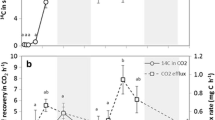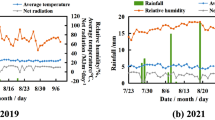Abstract
The system consisting of a few proportional detectors with appropriate electronic components was earlier developed for in vivo studies of long distance transport in whole maize seedlings. 14CO2 assimilation rate (Pa), time of radioactivity appearing in the loading region (AT), transport speed in the leaf (TSl), transport speed between the leaf and the roots (TSr), the maximum radioactivity values detected in the leaf below the feeding area (Rl) and in the mesocotyl (Rr) from leaves to roots in maize seedlings were calculated from the obtained temporal profiles of radioactivity. The study was undertaken to follow the changes in separate steps of long distance transport in maize seedlings as affected by two light irradiances and application of p-chloromercuribenzenesulphonic acid and fusicoccin, with the aim to investigate different steps of long distance transport, particularly phloem loading.
The method used allows to study in vivo the different aspects of long distance transport in maize seedlings, both qualitatively and quantitatively. It was shown that the characteristics obtained from the radioactivity profiles corresponded to different steps of long distance transport, as assimilate synthesis, phloem loading, and phloem translocation. It was also demonstrated that although active phloem loading participate in assimilate export from the leaves, assimilate transport along the maize seedling might undergo accordingly to assimilate gradient, particularly under light irradiance higher than during the growth.
Similar content being viewed by others
Abbreviations
- FC:
-
fusicoccin
- PCMBS:
-
p-chloromercuribenzenesulphonic acid
- GL:
-
irradiance under the growth conditions, 200 mol·m−2·s−1
- HL:
-
400 mol·m−2·s−1
- Pa :
-
14CO2 assimilation rate
- AT:
-
time of radioactivity appearance in the loading region
- Rl :
-
radioactivity of leaves near the feeding area
- Rm :
-
radioactivity of mesocotyl
- TSl :
-
speed of translocation in the leaf blade
- TSm :
-
speed of translocation between leaf and mesocotyl
References
Aducci P., Marra M., Fogliano V., Fullone M.R. 1995. Fusicoccin receptors: perception and transduction of the fusicoccin signal. J.Exp.Bot. 291:1463–1478.
Bourquin S., Bonnemain J.-L., Delrot S. 1990. Inhibition of loading of 14C-assimilates by p-chloromercuribenzenesulfonic acid. Plant Physiol. 92:97–102.
Bush D.R. 1989. Proton-coupled sucrose transport in plasmalemma vesicles isolated from sugar beet (Beta vulgaris L. cv. Great Western) leaves. Plant Physiol. 89:1318–1323.
Bush D.R. 1993. Proton-coupled sugar and amino acid transporters in plants. Ann. Rev. Plant Physiol. 44:513–42.
Farrar J.F., Minchin P.E.H., Thorpe M.R. 1994. Carbon import into barley roots: stimulation by galactose. J. Exp. Bot. 45:17–22.
Giaquinta R.T. 1983. Phloem loading of sucrose. Ann. Rev. Plant Physiol. 34:347–387.
Giaquinta R.T., Lin W., Sadler N.L., Franceschi V.R. 1983. Pathway of phloem unloading of sucrose in corn roots. Plant Physiol. 72:362–367.
Komor E., Orlich G., Weig A., Köckenberger W. 1996. Phloem loading — not metaphysical, only complex: towards a unified model of phloem loading. J. Exp. Bot. 47:1155–1164.
Körner Ch., Pelaez-Riedl S., Van Bel A.J.E. 1995. CO2 responsiveness of plants: a possible link to phloem loading. Plant, Cell & Env. 18:595–600.
Lorenc-Plucinska G. 1993. Inhibition of phloem loading by sulphite affects sugar distribution in pea leaves. Acta Soc. Bot. Pol. 62:175–178.
Lucas W.J., Madore M.A. 1988. Recent advances in sugar transport. The Biochemistry of Plants 14: 35–83.
Magnuson C.E., Goeschl J.D., Fares Y. 1986. Experimental tests of the Münch-Horwitz theory of phloem transport: effects of loading rates. Plant, Cell and Env. 9:103–109.
Opaskornkul C., Greger M., Tillberg J.-E. 1994. Effects of apoplastic sucrose on carbohydrate pools and sucrose efflux of mesophyll protoplasts of pea (Pisum sativum). Physiol. Plant. 90:685–691.
Sjölund R.D. 1997. The phloem sieve element: a river runs through it. The Plant Cell. 9:1137–1146.
Sowiński P. 1995. Transport of assimilates from leaves to roots in chilling-treated maize seedlings. Acta Physiol. Plant. 17: 341–348.
Sowiński P. & Królikowski, Z. 1995. Chilling sensitivity in maize seedlings. III. Relations between growth and functioning at low temperatures and during post-stress recovery. Acta Physiol. Plant. 17:219–224.
Sowiński P., Bednarek B., Kowalski T.Z., Ostrowski K.W. 1990. An “in vivo” method for the study of 14C-assimilates transport to the roots using the proportional counters as a radiation detector. Acta Physiol. Plant. 12:139–148.
Sowiński P., Richner W., Soldati A., Stamp P. Assimilate transport in maize (Zea mays L.) seedlings at vertical low temperature gradients in the root zone. J.Exp.Bot. in press
Stout R.G. 1988. Fusicoccin activity and binding in Arabidopsis thaliana. Plant Physiol. 88:999–1001.
Thompson R.G., Fensom D.S., Anderson R.R., Dronin R., Leiper W. 1979. Translocation of 11C from leaves of Helianthus, Heracleum, Nymphoides, Ipomoea, Tropaeolum, Zea, Fraximus, Ulmus, Picea, and Pinus: comparative shapes and some fine structure profiles. Can. J. Bot. 57:845–863.
Thompson R.G., Dale J.E. 1981. Export of 14C- and 11C-labeled assimilate from wheat and maize leaves: effects of parachloromercurobenzylsulphonic acid and fusicoccin and of potassium deficiency. Can. J. Bot. 59:2439–2444.
Thorpe M.R., Minchin P.E.H. 1987. Effects of anoxia on phloem loading in C3 and C4 species. J. Exp. Bot. 38:221–232.
Troughton J.H., Currie B.G., Chang F.H. 1977. Relations between light level, sucrose concentration, and translocation of carbon 11 in Zea mays leaves. Plant Physiol. 59:808–820.
Author information
Authors and Affiliations
Rights and permissions
About this article
Cite this article
Sowiński, P. The effect of irradiance, p-chloromercuribenzenesulphonic acid and fusicoccin on the long distance transport in Zea mays L. seedlings. Acta Physiol Plant 20, 79–84 (1998). https://doi.org/10.1007/s11738-998-0047-8
Received:
Accepted:
Issue Date:
DOI: https://doi.org/10.1007/s11738-998-0047-8




